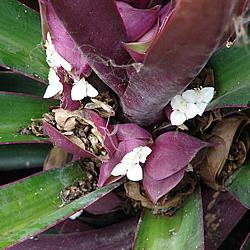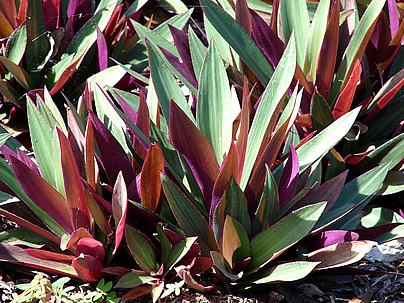The Moses in a Cradle (Tradescantia spathacea) is a herbaceous, rhizomatous plant with perennial and colorful foliage, cultivated in different tropical regions of the world for its ornamental qualities. It forms dense and symmetrical rosettes with upright, concave, and lanceolate leaves. Typically, the upper side of the leaves is olive green, and the lower side is violet, but there is a variety with completely green leaves, the ‘Concolor,’ and one with variegated leaves featuring red and yellow stripes, the ‘Vittata.’
As the plant grows and the lower leaves fall off, the short stem is revealed, but the plant rarely exceeds a meter in height. It blooms in spring and summer, producing inflorescences in racemes in the leaf axils. The inflorescences consist of pairs of bracts, resembling a small boat or canoe in shape, and small white, trimerous, and ephemeral flowers of little ornamental importance. The fruit formed is a capsule.

In landscaping, the Moses in a Cradle is an excellent tropical ground cover. The attractive colors of its foliage, along with the peculiar texture and geometric effect of the rosettes, create interesting contrasts in the garden. Use it in masses or borders under full sun or partial shade, adjacent to well-maintained lawns, ground covers of different colors, or in compositions with other equally geometric plants, such as agaves and bromeliads, for example. It is also perfect for rocky gardens, growing between crevices. It can be planted in pots and containers and is a preferred choice for terrariums.
It can be cultivated in various light conditions, from full sun to diffused light indoors. It prefers soils rich in organic matter but perfectly draining. Nevertheless, it can thrive on poor and rocky soils.
The Moses in a Cradle appreciates irrigation, especially in the first months after planting. Once well-adapted, it becomes tolerant to short periods of drought. An annual drastic pruning, performed in early spring, can renew its vigor and the beauty of its foliage. With proper coverage, it can withstand intense cold and even frost. It easily multiplies through clump division, cutting of branches, or by seeds.


